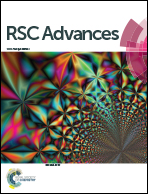One-step fabrication of polymeric hybrid particles with core–shell, patchy, patchy Janus and Janus architectures via a microfluidic-assisted phase separation process†
Abstract
We report in this paper a one-step route for the preparation of core–shell, patchy, patchy Janus and Janus particles via a microfluidic-assisted phase separation process. As a proof of concept, PLGA/PCL hybrid particles are fabricated and the results show that the four types of particles can be harvested with high yield and narrow size distribution by precise control over the phase separation process, or namely, interfacial tensions and spreading coefficients between immiscible phases, after generation of the single emulsion in microchannels. This new strategy described herein is rather simple and versatile for producing a wide range of other particles with simultaneously controlled size, shape and anisotropy.



 Please wait while we load your content...
Please wait while we load your content...